

News in 2021
|
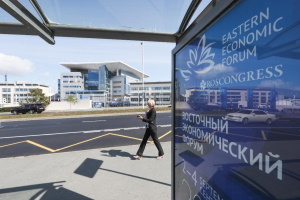
Photo: Roscongress |
The discussion held by the Federal Service for State Registration, Cadastre and Cartography (Rosreestr) focused on the role of spatial data in land management - what government’s decisions on land resources are required by the new trends, how can be land more effectively managed, what tools and services can be used to increase the availability and quality of real property? |
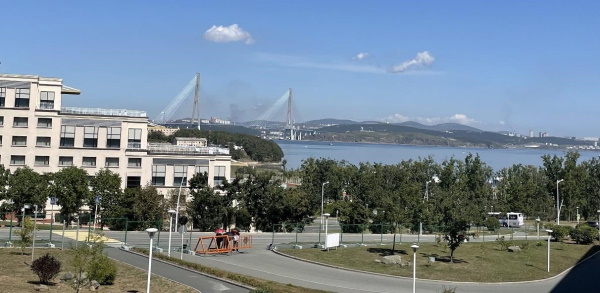
Vladivostok, Russia - Photo: Daria Svistunova
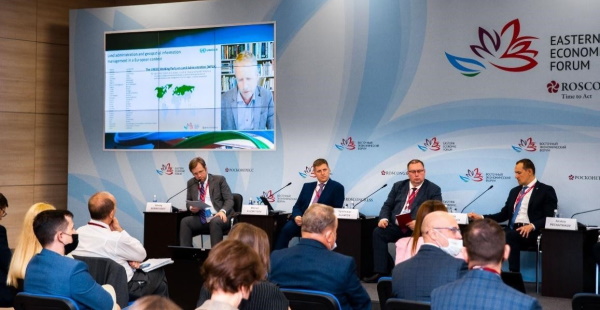
Fredrik Zetterquist addressing online, Photo: Rosreestr
The Working Party recently launched a scenario study on future national arrangements of land administration and geospatial information management in the region. A survey among land administration authorities suggests that the arrangements tend to move from the Conventional scenario towards digitally enabled ecosystems and with more inclusion of the private sector (figure 1).
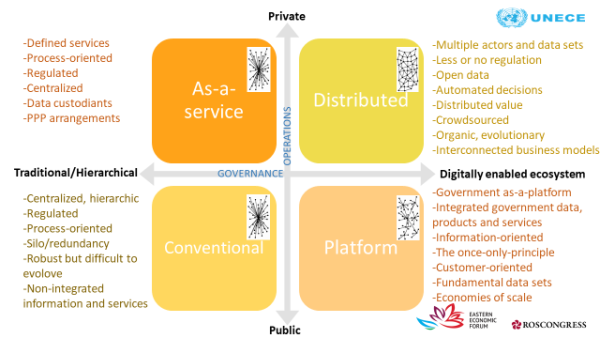
Figure 1. Four future scenarios based on global megatrends and domain-specific drivers
The Conventional scenario is characterized by a process-oriented hierarchical organization with the State in the driver’s seat and data captured and updated in a controlled way, resulting in authoritative data. Services, processes as well as conditions and performance of professionals are strictly regulated. Often, the various data sets are stored in several silos with a risk of work redundancy and overlap of information. While national arrangements in this scenario often can be considered as robust, they tend to be characterized by constraints to evolve, develop new capabilities and meet new expectations.
In the Platform scenario, land administration and geospatial information management is part of a federated system architecture, often referred to as Government-as-a-platform. Typically, a range of key registers with national data sets are included, sometimes within a government cloud. The once-only principle is applied for data capture in order to avoid work redundancy and data duplication and inconsistency. This arrangement facilitates the provision of data-centric applications and has the potential to provide economies of scale for the Government while, at the same time, improve the sharing of integrated national data sets and capabilities across organizations and sector boundaries.
The so-called Distributed scenario is the most visionary one. It represents an environment with a highly automated and multi-stakeholder arrangement, where the private sector has a large stake and where governance is moving to an ecosystem of technologies, platforms and diverse sets of stakeholders. The widened opportunities for the integration of data from multiple providers, combined with an open data policy, require a high degree of standardization and stringent policies on compliance with data privacy and data security regulations. The concept facilitates process automation and transparency, and enables a wide spectra of user applications. It also provides for a built-in evolutionary environment that, in a complex context, could transform and adapt to new customer expectations over time. It has the potential to trigger digital engagements and efficiently leverage digital trust.
The conducted survey indicates the position of the different national arrangements today and the expected, as well as desired, position in 2030. A shift of the national arrangements towards a more digitally enabled environment is expected. Even the short period prior and after the pandemic indicate a shift of the current state.
The study will be used as a dialogue instrument to continuously refine the scenarios and discuss appropriate actions to be made in order for the responsible state authorities to remain relevant well into the future.
Today’s challenges are many, complex and interlinked. To name just a few: the global health crises; climate change and the increased intensity and frequency of natural disasters; rapid urbanization; ever increasing demand for natural resources; increased food, water and energy insecurity; emerging violent conflicts; large migration, and the list goes on.

Rumyana Tonchovska addressing online Photo: Rosreestr |
Most of data needed to respond to those challenges are location based data. “Covid-19 pandemic not only created new social, economic and health challenges, but reinforced the pre-existing obstacles, such as lack of timely fundamental data and enabling technologies to measure and monitor what is happening where, when, and how.” –UN-GGIM. |
At the European level the EU INSPIRE Directive from 2003 makes it mandatory for all EU MS to prepare a national legislation, to make all 34 data themes interoperable based on adoption of common International standards and share them in a not restrictive way. Other countries from the region are using the EU MS experience to advance the development of their NSDIs. The process of data harmonization is going not as quickly as expected and the EU is looking for collection of good practices and innovations for facilitating data sharing, using AI and ML for example.
At the UN level, the First United Nations World Geospatial Information Congress in China in 2018, substantively improved the understanding of the role of geospatial information management, innovation and related technologies. India is going to host the second United Nations World Geospatial Information Congress (UNWGIC) in 2022.
UN-GGIM together with the World Bank and other partners developed the Integrated Geospatial Information Framework an Implementing guide covering GOVERNANCE, TECHNOLOGY and PEOPLE.
FAO together with the World Bank developed a methodology for development of country level action plans, which includes several steps:
In July 2021 a socio-economic benefit analyses in Serbia shows the rate of return of investments in SDI 5:1 during the next 10 years. The socio-economic benefits analyses Mongolia in 2020 provided a justification for financing by the WB a new Digital Development Project with a vision: Geo-driven eGovernment and innovation that empowers efficient and effective use of geospatial information towards national sustainable development and economic growth. – planned to start in 2022.
The experience from the developed Action Plans shows that land data are coming as a top priority data sets, no matter if government key focus is on climate change mitigation; social and environmental protection; health; infrastructure development; green growth or economic development. This is not a surprise as out of the 14 Fundamental Data Themes, identified by the UN-GGIM as critical for every nation to survive, about 11 are maintained by the Cadastre and mapping authorities.
The FAO currently is supporting the implementation of a large scale land governance and SDI projects, funded by the World Bank with a total amount of above 2+ billion USD. All those projects contribute to the NSDI. For example in Viet Nam, we are supporting the establishment of land database and a multi-purpose land administration system, which is part of the NSDI and a wider e-Government program.
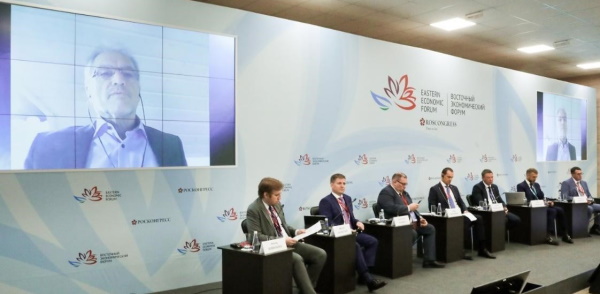
Hartmut Müller addressing online Photo: Roscongress
Place matters. Observing and communicating the role of geospatial data in land administration and management, tools and services provided by the underlying technologies of spatial information management, all this is part of the mission of the International Association of Surveyors (FIG). The following discuss some experiences from a specifically European and German perspective.
The European level. In the European Community the so-called INSPIRE directive is in place, where INSPIRE is an acronym of Infrastructure for Spatial Information. The directive came into force back in 2007. INSPIRE is based on the geospatial data infrastructures of all Member States of the European Union. The Directive addresses 34 spatial data themes and is, thus, a comprehensive use case of an integrated interoperable Spatial Information System for the heterogeneous region of the European Community. INSPIRE builds strictly on international standards, World Wide Web (WWW), Open Geospatial Consortium (OGC), International Standardization Organization (ISO). The pluralism in national solutions was integrated at the European level into a data platform based on the input from individual member states and their systems. Implementation is not an easy task, but the concept is of very high value.
Numerous tools have been developed to support implementation of this cross border geospatial information infrastructure. Sets of implementation rules, clearly defined process steps for the entire data specification cycle, code lists, and so forth are publicly available. With these tools, INSPIRE supports conceptually its own extension while preserving the conformance of the framework. Parts of the overall approach could possibly be used and adapted to create a universal spatial data system for other world regions such as the large Far East countries.
Two of the 34 INSPIRE themes could be of particular interest to start with. One is the Cadastral Parcel theme, where spatial objects are defined as areas in cadastral registers, and the other is the Land Use theme, that is itself split in two different types, the Existing Land Use and the Planned Land Use. A List of land use categories is available in INSPIRE, agreed at the European level, called Hierarchical INSPIRE Land Use Classification System (HILUCS). The elements of the list, starting with primary production and not ending with cultural entertainment, cover almost 100 land use classes and should be both applicable to existing land use and planned land use. Up to date and accurate geospatial information can support the adequate use of land in economic and other activities by appropriate service delivery via Internet.
The German national level. Germany, one of the founding members of the European Community, has established its own National Spatial Data Infrastructure more or less simultaneously with the European developments. The goal was and is to serve the specific needs of the German society while maintaining compatibility with the European framework. One example is the documentation of land property in the German cadastral system. The European system INSPIRE focuses on the geometrical aspects of land but does not address ownership and rights related to the parcels. In the German national system there is a close link between the geometric shape and the ownership of land. In addition, data on purchase prices of land in Germany are publicly available. Under the German Building code all real estate transactions must be notorized, and information from the notarized deeds must be provided to public agencies. Purchase price data is regularly compiled by responsible appraisal committees. Reports and detailed maps for standard land values are available, which is a potential resource for a unified information system on land and property. Harmonization of data bases held by various public agencies and banks is still a wish, but the technical tools are available. Progress is still needed towards the integration of the information into the overarching common German National Strategy for Geoinformation.
In conclusion, Europe and Germany are on their way to providing interoperable digital geospatial information for many themes, including but not limited to land and real estate, but have not yet reached the end of this journey.
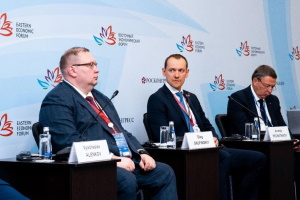 Oleg Skufinskiy (in the middle) Photo: Rosreestr |
Global trends in spatial development indicate the growing role of large
urban agglomerations. Agglomerations today concentrate the main
potential of the country's economic growth, and are large labor and real
property markets, centers of production and consumption. Russia is no
exception in this regard. |
Rosreestr is faced with the ambitious task of consolidating spatial data, which is aimed at increasing the efficiency of land use and involving land in turnover, accelerating procedures in the field of land management, appraisal, provision and registration of land plots, and much more.
Currently, Russia has approved the state program "National Spatial Data System", which should become a development tool, increase the capitalization of the country's territory and improve the quality of real property transactions. The state program involves the creation of a unified geospatial data platform that will serve as a digital basis for all future transformations and modernization of the industry.
The first step towards a unified spatial data system has already been taken - in 2021, we implemented a pilot project to create a Unified Information Resource on Land and Real Estate. In addition to Rosreestr, 10 more government agencies are involved in the experiment. Within the framework of the project, 21 information systems are being integrated, 86 information layers are being formed with data on land and real property, new digital services are being developed in the interests of people: "Land Simple", "Land for construction", "Analysis of the state and use of land", analytical service based on pre-trained neural networks and spatial analysis algorithms "Smart Cadastre", 3D terrain models, geocoding of address register objects and a service for assessing the economic potential of a territory.
This will provide citizens, the state and business with access to the most complete information about each specific land plot, including information on the construction of housing and the provision of land plots, as well as involve unused land into economic turnover.
Rosreestr has extensive experience in the technological support of information systems containing spatial data.
Since 2016, the agency has been maintaining the information system of
the “Far Eastern Hectare” program, which allows interested citizens to
obtain land in the Far East for free in order to develop territories and
foster entrepreneurship. The system ensures electronic exchange of
documents between citizens and authorities.
The system is integrated with the Public Cadastral Map of Rosreestr,
which allows quick recording of up-to-date information about lands.
Conclusion: Rosreestr is changing and becoming a service provider and a
source of complete, reliable and relevant spatial data for citizens,
business and professional communities, government bodies, a center of
competence for land and real property. Our key principles are customer
focus, ecosystem approach, technological effectiveness and velocity.
Louise Friis-Hansen
28 December 2021